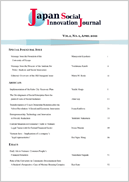Volume 2, Issue 1
Special Double Issue on Crisis Management and Social Innovation and Current Topics on the EU – Guest editors: Ryosuke Aota
Displaying 1-11 of 11 articles from this issue
- |<
- <
- 1
- >
- >|
Editor’s Introduction
-
2012 Volume 2 Issue 1 Pages iii
Published: March 05, 2012
Released on J-STAGE: April 09, 2013
Download PDF (29K)
Articles
-
2012 Volume 2 Issue 1 Pages 1-17
Published: March 05, 2012
Released on J-STAGE: April 09, 2013
Download PDF (427K) -
2012 Volume 2 Issue 1 Pages 18-25
Published: March 05, 2012
Released on J-STAGE: April 09, 2013
Download PDF (143K) -
2012 Volume 2 Issue 1 Pages 26-35
Published: March 05, 2012
Released on J-STAGE: April 09, 2013
Download PDF (311K) -
2012 Volume 2 Issue 1 Pages 36-53
Published: March 05, 2012
Released on J-STAGE: April 09, 2013
Download PDF (349K) -
2012 Volume 2 Issue 1 Pages 54-63
Published: March 05, 2012
Released on J-STAGE: April 09, 2013
Download PDF (250K) -
2012 Volume 2 Issue 1 Pages 64-71
Published: March 05, 2012
Released on J-STAGE: April 09, 2013
Download PDF (79K)
Research Notes
-
2012 Volume 2 Issue 1 Pages 72-76
Published: March 05, 2012
Released on J-STAGE: April 09, 2013
Download PDF (137K) -
2012 Volume 2 Issue 1 Pages 77-81
Published: March 05, 2012
Released on J-STAGE: April 09, 2013
Download PDF (125K)
Essays: Voices
-
2012 Volume 2 Issue 1 Pages 82-83
Published: March 05, 2012
Released on J-STAGE: April 09, 2013
Download PDF (208K) -
2012 Volume 2 Issue 1 Pages 84-85
Published: March 05, 2012
Released on J-STAGE: April 09, 2013
Download PDF (274K)
- |<
- <
- 1
- >
- >|
